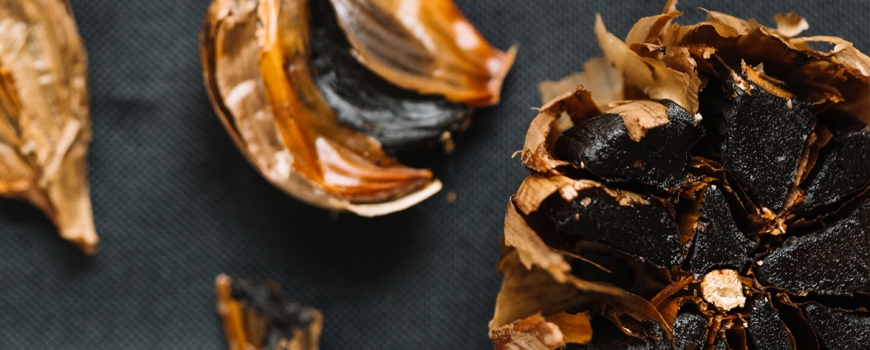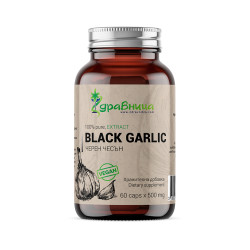Black garlic is regular garlic (Allium sativum) that has undergone a fermentation-like process involving controlled heat (60–90°C) and humidity (70–90%) for several weeks. This transforms its flavor, color, and chemical composition. The harsh, pungent aroma of raw garlic softens, becoming sweet and caramel-like, while its cloves turn jet black.
Black garlic originated in Asia, most likely in Korea, and has been used in traditional medicine for centuries. Today, it is popular worldwide in both culinary and health contexts.
S-Allyl Cysteine – The Key Compound in Black Garlic
During fermentation, allicin – the unstable, pungent compound in raw garlic – is converted into S-Allyl Cysteine (SAC), a stable, water-soluble, and highly bioavailable antioxidant.
Scientific studies have shown that SAC:
- Has strong antioxidant properties
- Offers anti-inflammatory effects
- Provides liver protection
- Supports cardiovascular health
SAC is considered one of the most important bioactive ingredients in black garlic, responsible for many of its health benefits.
(Source: Nishimura et al., 2006; Choi et al., 2014)
Effects on the Cardiovascular, Digestive, and Immune Systems
Cardiovascular System
Black garlic and SAC contribute to heart health by:
- Lowering LDL ("bad") cholesterol
- Raising HDL ("good") cholesterol
- Improving blood circulation
- Reducing platelet aggregation, which helps prevent clots
(Source: Ryu et al., 2009)
Digestive System
Compared to raw garlic, black garlic is gentler on the digestive tract:
- Helps maintain a balanced gut microbiota
- Supports healthy digestion without irritation
- Has mild prebiotic effects
Immune System
Black garlic helps strengthen the immune response by:
- Stimulating white blood cell activity
- Enhancing the body's defense against viruses and bacteria
- Exhibiting natural antimicrobial and antiviral actions
(Source: Lawson et al., 2005)
Other Health Benefits of Black Garlic
- Anticancer potential – Some in-vitro studies suggest black garlic extract may inhibit cancer cell growth (Source: Kimura et al., 2017)
- Neuroprotection – SAC helps protect brain cells from oxidative stress and may reduce the risk of cognitive decline
- Blood sugar control – Supports insulin sensitivity and glucose metabolism, especially in people with type 2 diabetes
- Anti-aging effects – High antioxidant content helps slow down cellular aging and oxidative damage
Differences Between Raw Garlic and Black Garlic
While both come from the same plant, they differ significantly in taste, composition, and tolerability:
Taste:
Raw garlic is sharp, spicy, and pungent
Black garlic is sweet, soft, and savory with a balsamic-like flavor
Smell:
Raw garlic has a strong odor
Black garlic has little to no odor
Digestibility:
Black garlic is easier to digest and does not irritate the stomach
Active compounds:
Raw garlic contains allicin (unstable)
Black garlic contains S-Allyl Cysteine (stable and more bioavailable)
Suitability for daily use:
Black garlic is more suitable for regular consumption due to its mild nature
Detoxification and Parasite Defense
Black garlic can assist in natural detoxification processes:
Activates liver enzymes such as glutathione peroxidase
Supports the elimination of toxins and heavy metals
Has a gentle diuretic effect, aiding in cleansing the kidneys
It also exhibits antiparasitic and antifungal effects, helping to disrupt the metabolism of intestinal parasites and fungi with continued use.
Black garlic is more than a trendy superfood – it’s a functional, evidence-backed health enhancer. Rich in stable antioxidants like SAC, it offers wide-ranging benefits for the heart, brain, liver, immune system, and gut. Unlike raw garlic, it’s tasty, gentle, and suitable for daily use, making it an ideal addition to any health-conscious diet.
References
Nishimura, M. et al. (2006). Antioxidative effects of S-Allyl Cysteine. PubMed
Choi, I. S. et al. (2014). Hepatoprotective effects of aged black garlic. PubMed
Ryu, J. H. et al. (2009). Lipid profile improvement in humans by black garlic. PubMed
Lawson, L. D. et al. (2005). Garlic and its antimicrobial properties. PubMed
Kimura, S. et al. (2017). Antitumor effects of black garlic extract. PubMed




